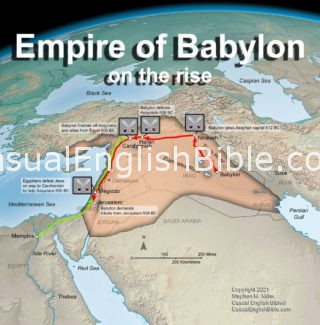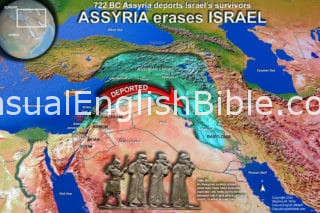Sin city
“Sin city, where crime calls home….the city where sin never sleeps” (3:1).
That’s how Nahum described Nineveh, capital of the vicious Assyrian Empire, before predicting it’s going to get erased.
Jonah came first
A hundred years before Nahum, in the 700s BC, a reluctant prophet named Jonah delivered a similar message:
“In 40 days Nineveh will be destroyed” (Jonah 1:4).
Didn’t happen.
The Assyrian king ordered the people to repent. Everyone fasted and dressed in mourning clothes made of scratchy feed sack fabric. “Humans and animals alike” (Jonah 3:8).
That last line (try dressing a bull in a feed sack) is one of several reasons some scholars say they read Jonah as a parable about God’s concern for everyone, not just for the Jews.
But in Nahum’s message, God is fed up with the Assyrians and concerned for the Jews. So much so that he said he would put a permanent end to the Assyrian Empire:
“Shepherds who led your nation are sleeping.
Great King of Assyria, they’ll never wake up.
What’s left of your people now hide in the hills.
There are no shepherds left to lead them” (3:18).
Babylonians from what is now southern Iraq not only overran the Assyrian Empire and took control of a swath of what is today the Middle East. They recorded the history.
Some of the documents, known as the Babylonian Chronicles, have the stories about it pressed into dried clay, written in wedge-shaped cuneiform characters:
“The king of Babylonia called out his army and…pitched camp by Nineveh…They made a strong attack…They carried off much spoil from the city and temple area and turned the city into a ruin mound and heap of debris.”
The city remains a ruin today, as Nahum said: “Gone for good” (1:15)
WRITER
Nahum, from Elkosh (1:1) is the reported source of this prophecy, whether he wrote it or spoke it.
Who he was, what he was, and where he came from all remain a mystery.
His name shows up in the Bible only here. Someone else by that name shows up in the family tree of Jesus in Luke 3:25.
Nahum isn’t identified as a prophet. He is someone who had a vision which became the three chapters in the Book of Nahum.
Location of Elkosh is unknown. Some scholars say they wonder if Elkosh ever existed. Jewish scholars writing in the Targum, an ancient collection of Jewish Bible commentaries, said Elkosh might be a symbolic way of describing what God was going to do to Nineveh. Elkosh is a Hebrew wordplay that means “God is harsh.”
TIMELINE
Nahum lived sometime during a 50-year stretch in the 600s BC, scholars guess.
That guess comes from two clues.
1. Nahum reports the fall of Thebes, a city in Egypt. Assyrians conquered it in 663 BC.
2. And Nahum predicts the fall of Assyria, which happened in 612 BC.
However, it is possible someone preserved the story in writing long after Assyria fell, and simply tried to present the story in the voice of Nahum.
 LOCATION
LOCATION
Nahum’s warning was for Nineveh, capital of the vicious Assyrian Empire. Nineveh’s ruins are on the east side of the Tigris River, across from the city of Mosul.
Yet what served as a warning for Assyria, also served as a message of consolation, retribution, and hope for the southern Israelite nation of Judah.
“Go ahead, Judah, celebrate your festivals.
Make your vows to the LORD.
Your enemy will never come back.
They are as good as dead and gone for good” (1:15)
The northern Israelite nation of Israel was long gone. Assyrians wiped it off the political map in 722 BC and deported many of the survivors.
Judah remained under Assyria’s thumb and was forced to pay tribute in taxes and gifts. But in 612 BC, Babylon defeated Assyria. Power shifted from the Assyrian Empire in what is now northern Iraq, to Babylon and the Babylonian Empire based in southern Iraq.
PURPOSE
Nineveh was going to fall and never rise again.
That’s the message Nahum delivered about the capital of the Assyrian Empire.
Assyria had been terrorizing what is now the Middle East for about three centuries. So, Nahum’s prophecy was good news to Israelites in the southern Jewish nation of Judah.

 “Shepherds who led your nation are sleeping.
“Shepherds who led your nation are sleeping.


